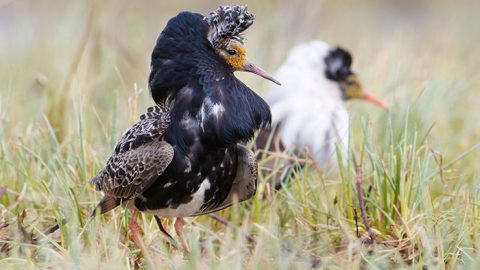How Inversions and Supergenes Can Keep Similar Species From Merging
By Marc Devokaitis
October 29, 2024
Originally published in the Spring 2022 issue of Living Bird magazine; updated October 2024. Subscribe now.
The genomes of Baltimore and Bullock’s Oriole are almost identical, but one key point of difference is a chromosomal inversion within a set of hundreds of genes, including genes that appear to account for the different range of orange and black coloration between the two species.
Jennifer Walsh, a researcher in the Cornell Lab of Ornithology’s Center for Biodiversity Studies, discovered the chromosomal inversion when mapping the two orioles’ genomes, and she says it may be a reason that distinct oriole species arose from a single ancestral species—and stayed separate.
That’s because chromosomal inversions, genetically speaking, have staying power. The inverted section of one parent’s chromosome cannot successfully recombine with the non-inverted section of the other parent’s chromosome during meiosis, when the DNA combines, splits, and combines again. Chromosomal inversions can happen within a single species as well, and sometimes they give rise to what evolutionary biologists call a “supergene.”
That may sound like a caped hero from a children’s biology book, but supergenes are more like characters in a mystery—and they’ve been key to several recent studies aiming to solve the puzzle of how species diverge and evolve.
A supergene is a region of DNA that contains closely linked traits. When a supergene is inverted, it creates a pathway for that entire suite of traits to get passed down as a unit, sometimes leading to fascinating adaptations.
In White-throated Sparrows, for example, two supergenes underpin a unique reproductive strategy. The species has, in effect, four sexes—”white-striped” male and female and “tan-striped” male and female. White-striped birds mate almost exclusively with tan-striped birds, and vice versa. The inverted supergenes play a part in maintaining this mix of different forms within a single species.
In Ruffs, which are large Eurasian shorebirds, a supergene resulted in three distinct plumage patterns for male birds. The Ruff supergene also underlies a complex and unlikely mating system in which a small percentage of males grow up to look like females and sneak their way into reproductive success. (See Among Ruffs, Some Fight-Loving Fighters Don’t Like to Fight, Summer 2018.)

The two extremes of redpoll appearance. On one end, there are particularly dark and red Common Redpolls. Photo by Bruce Gates/Macaulay Library. 
On the other end, there are very white Hoary Redpolls. Photo by Christoph Moning/Macaulay Library.
Most recently a supergene has been identified that plays a part in plumage variation in the much-debated redpoll complex. Common and Hoary Redpolls are considered to be separate species as of this writing. But research published in the journal Nature Communications in November suggests that Common and Hoary Redpoll genes regularly get mixed around through interbreeding, with the supergene playing a part in maintaining the differences in appearance between the streakier, larger-billed Common Redpoll and the paler, smaller-billed Hoary Redpoll.
More On Supergenes
“I think, solidly now, the new paper shows that there is widespread gene flow across the [redpolls’] genome, except for this one region, and it just so happens this one region influences how they look,” says University of Colorado Boulder scientist Scott Taylor, an author on the paper and former Cornell Lab postdoctoral fellow.
Irby Lovette, director of the Cornell Lab’s Fuller Evolutionary Biology Program, says the new findings add weight to the idea that the redpolls might actually be one species: “I think it would be hard…not to lump the redpolls based on those new findings.” [Update: In 2024 this came to pass: Common, Hoary, and Lesser Redpolls were lumped into a single species, now called simply Redpoll.]
In the case of the orioles, Walsh says it’s not proven that the Baltimore–Bullock’s inversion is a supergene because there is still no research that directly links the inverted genes with reproductive fitness or appearance—but she wouldn’t rule it out. Walsh calls the oriole chromosomal inversion “a major region of interest” in the search for the next avian supergene.
All About Birds
is a free resource
Available for everyone,
funded by donors like you
American Kestrel by Blair Dudeck / Macaulay Library









